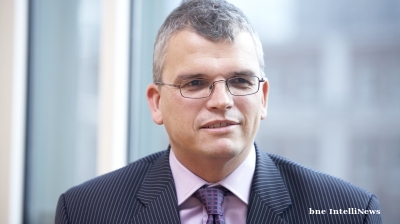For Russian President Vladimir Putin, his invasion of Ukraine is not only an attempt to subdue, and possibly destroy, the Ukrainian nation; it is also the key front in his long-standing desire to upend the global order. The Kremlin has long carped that current international structures, regimes and institutions are biased in favour of the West, which for its part is clear that the Kremlin is a threat to what it terms the ‘rules-based international order’.
Broadly understood as the institutions of global governance from structures like the Organisation for Economic Cooperation and Development (OECD) to the G7, to the international rule of law, Russia’s ire at the system has often been dismissed in the West.
Critics of the order often point out that major powers often violate its norms, including Russia, pointing to the lack of repercussions for its role in Syria, for example. Moscow in turn does the same for the United States, which it accuses both of having structured the system in its favour and being its most frequent violator, pointing for example to its own role in Syria, or neighbouring Iraq.
One of the aspects of this order that Russia has criticised most frequently is the international financial system, and in particular the role of the US dollar and US Treasuries bills in underpinning it. As the core instruments of international trade, reserves and finance, the dollar system is arguably more important to the US’ global role than even its gargantuan defences budgets. And Russia is by no means alone in criticising its structure and Washington’s dominance.
The key challenger to this system is not Russia. Even in its pre-2014 economic heyday Russia was never seen as a potential centre of an alternative system; its oligarchs and state enterprises clearly enjoyed the benefits of the Western system, including using it to raise finance and stash their cash. However, that China also desires an alternative system has been increasingly clear in recent years, often lumped together as merely part of its ‘Belt and Road’ strategy, when in reality that approach is really just the key early prong in globalising Chinese finance.
Beijing has been making progress on more technical, and therefore less headline-grabbing developments over the last decade as well. It has signed numerous new bilateral investment treaties, established its own arbitration courts to oversee disputes that those treaties often mandate be heard in these new fora, and has been developing its own financial markets, including seeking to promote renminbi-denominated finance for projects abroad. But it still has a closed capital market, the reform of which would be key to establishing a true alternative to the global dollar system.
China, of course, has a deep interdependence with the West, and in particular with the US dollar system, given its role in buying treasuries in addition to the trade links. While the latter frayed after the Trump Administration began the still-ongoing tariff and trade war with Beijing, the former remained largely unbroken.
China’s strategy of challenging the dollar system seems to be a methodical and therefore inherently slow one. Beijing recognises that the dollar system emerged not as a result of intentional US policy, but rather more as the result of a series of convenient mistakes. When President Richard Nixon withdrew the US from the gold standard – upending the core pledge of the post-World War II system that meant US securities to which restructuring Europe and the developing world were tied were ultimately exchangeable for gold – his aim was to help tame inflation and protect US reserves, not to substitute the dollar for gold.
At the time, capital controls were still common across the world, even considered Western orthodoxy. One of the results of the Nixon shock was the emergence of gradual holes in this regime as central bankers and financiers changed their approach to the economic trilemma – the idea that countries can choose to have sovereignty over only two of three key policy choices: maintaining fixed exchange rates, allowing capital to flow freely, and operating an independent monetary policy – the ability to set interest rates.
Whereas there was previously a preference for fixed exchange rates and independent monetary policy, the new dollar system – in part through the birth of the Eurodollar, i.e. dollars created by foreign bank loans – subsequently the world moved to a system of free capital flows and independent monetary policy, but floating exchange rates. US attempts to manage international exchange rates would continue through the 1980s, most notably in the Louvre and Plaza Accords, but the ultimate impact was to drive the US dollar to new heights. While Gresham’s law holds that bad money chases out good in any domestic system, in international capital markets, the opposite occurs. By the time the Soviet Union collapsed, the dollar system as it is presently understood was in full swing, even if this was never Washington’s intent.
The difference between Beijing’s approach and the development of the dollar system is that Beijing appears to be learning from these past examples. Beijing believes it can ultimately replace it but is in no rush to do so.
Therefore when Putin invaded Ukraine, and the West responded with draconian sanctions that rapidly cut Russia off from the dollar system, he miscalculated. The overreach of Russia’s invasion has long since been recognised, after the Kremlin acknowledged it with its withdrawal from Ukraine’s Kyiv, Chernihiv and Sumy Oblasts at the beginning of April.
Even in the war’s early weeks, however, there were signs that Beijing was not going to ally with Russia in its attempts to challenge and undermine the dollar system. The primarily Chinese-funded New Development Bank (previously called the BRICS Bank) halted all transactions in Russia on March 3, though Russia was a capital member. China’s Asian Infrastructure Investment Bank did so as well.
Five months on in Putin’s war, prognostications about its ultimate outcome on the battlefield remain mixed. Ukrainian officials are raising hopes for counter-attacks in the south, around Kherson, while Russian officials, on the back of grinding advances in the Donbas, threaten to seize ever more Ukrainian territory.
But while China has refused to condemn Russia’s invasion of Ukraine, even supporting Moscow at the United Nations, and increased trade to replace sanctioned Russian goods, it is not offering Russia the kind of credit or investment that it needs to sustain a true challenge to the dollar system.
In recent weeks Beijing has frozen plans to develop a civilian airliner with Russia, once envisaged as worth more than $50bn. In March Beijing reportedly suspended discussions on developing a new major petrochemical plant. The similar $10bn Amur Gas Chemical Complex, 40% owned by China's state-run Sinopec, appears to be continuing, though it has been beset by sanctions challenges that may delay its anticipated 2024 completion date. Just before the war Russia and China agreed a new gas supply contract and plan to build the Power of Siberia 2 Pipeline; the first such pipeline and a supply contract was agreed in the months after Putin's initial 2014 invasion of Ukraine. Supplies were to be settled in euros, though this too will likely have to be revisited as a result of Western sanctions. Though Mongolian officials have said they still expect the pipeline, which will partially run through their country, will go ahead, no official announcement from Beijing has been forthcoming. Chinese investment through the Belt and Road programme, meanwhile, has fallen to zero this year.
However, ultimately it is likely China will go ahead with the Power of Siberia 2 project. It can probably secure even steeper discounts than those it is believed to have received for the initial pipeline in 2014. Cheap commodities imports are, after all, the lifeblood of the Chinese economy. Beijing, however, recognises the inherent ‘anti-fragility’ of the US dollar system, that it tends to become stronger during international economic and political crises. The flight to so-called ‘safe assets’ continues, even as the US faces a likely recession and economic downturn, the dollar has reached 20-year highs.
Beijing appears set to see Russia as a source of little else than discounted commodities. Putin wants to wreck the international order; China wants to see it re-ordered. Putin’s war in Ukraine has proved more a threat to China’s strategy than an opportunity.
Maximilian Hess is a political risk and foreign policy analyst based in London. He also serves as a fellow at the Foreign Policy Research Institute in Philadelphia, Pennsylvania. Follow him on twitter at @zakavkaza
Opinion

COMMENT: US-brokered Armenia-Azerbaijan peace deal exposes Russia’s strategic failures
The recent peace breakthrough between Armenia and Azerbaijan is a major diplomatic win for the United States and a setback for Russia, according to a new report published by the Atlantic Council.

COMMENT: Why Beijing will never take Taiwan
Xi Jinping needs to think again before he sends so many young Chinese men and women to their deaths on Taiwan, for if the PLA does one day dare to land, they will be buried here.

COMMENT: Ukraine’s coming financial storm
“A crisis is drawing ever closer. It will break in Ukraine, but it won’t begin on the frontlines, where the country’s battle-weary brigades continue to impose a brutal cost on the Russian invader," writes Timothy Ash of BlueBay Asset Management.

BEYOND THE BOSPORUS: Performance postponed. Hotly anticipated “CHP” trial pushed into October
Every Turk up and down the country has an opinion on what Erdogan is up to.




